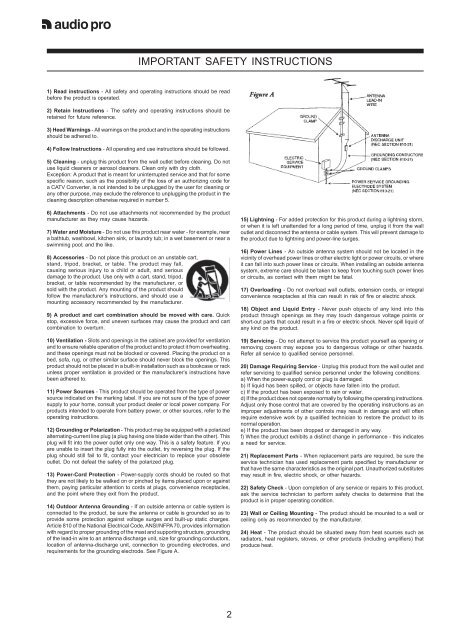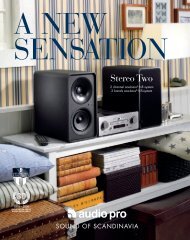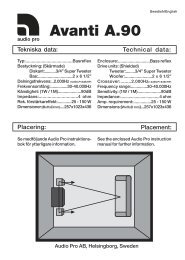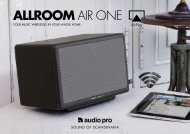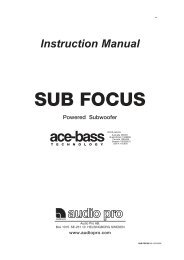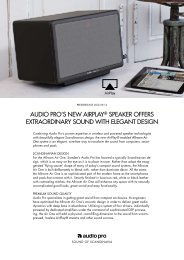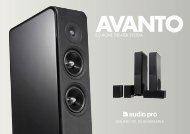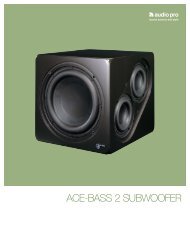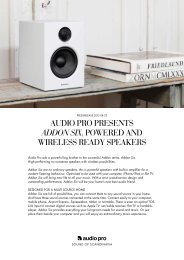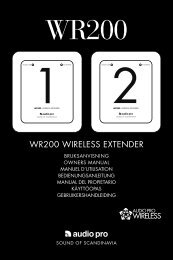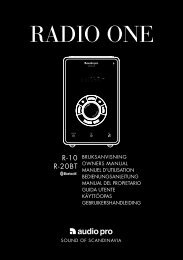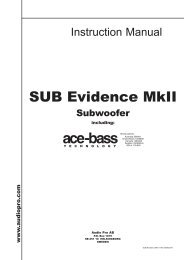Instruction Manual - Audio Pro
Instruction Manual - Audio Pro
Instruction Manual - Audio Pro
Create successful ePaper yourself
Turn your PDF publications into a flip-book with our unique Google optimized e-Paper software.
1) Read instructions - All safety and operating instructions should be read<br />
before the product is operated.<br />
2) Retain <strong>Instruction</strong>s - The safety and operating instructions should be<br />
retained for future reference.<br />
3) Heed Warnings - All warnings on the product and in the operating instructions<br />
should be adhered to.<br />
IMPORTANT SAFETY INSTRUCTIONS<br />
4) Follow <strong>Instruction</strong>s - All operating and use instructions should be followed.<br />
5) Cleaning - unplug this product from the wall outlet before cleaning. Do not<br />
use liquid cleaners or aerosol cleaners. Clean only with dry cloth.<br />
Exception: A product that is meant for uninterrupted service and that for some<br />
specific reason, such as the possibility of the loss of an authorizing code for<br />
a CATV Converter, is not intended to be unplugged by the user for cleaning or<br />
any other purpose, may exclude the reference to unplugging the product in the<br />
cleaning description otherwise required in number 5.<br />
6) Attachments - Do not use attachments not recommended by the product<br />
manufacturer as they may cause hazards.<br />
7) Water and Moisture - Do not use this product near water - for example, near<br />
a bathtub, washbowl, kitchen sink, or laundry tub; in a wet basement or near a<br />
swimming pool; and the like.<br />
8) Accessories - Do not place this product on an unstable cart,<br />
stand, tripod, bracket, or table. The product may fall,<br />
causing serious injury to a child or adult, and serious<br />
damage to the product. Use only with a cart, stand, tripod,<br />
bracket, or table recommended by the manufacturer, or<br />
sold with the product. Any mounting of the product should<br />
follow the manufacturer’s instructions, and should use a<br />
mounting accessory recommended by the manufacturer.<br />
9) A product and cart combination should be moved with care. Quick<br />
stop, excessive force, and uneven surfaces may cause the product and cart<br />
combination to overturn.<br />
10) Ventilation - Slots and openings in the cabinet are provided for ventilation<br />
and to ensure reliable operation of the product and to protect it from overheating,<br />
and these openings must not be blocked or covered. Placing the product on a<br />
bed, sofa, rug, or other similar surface should never block the openings. This<br />
product should not be placed in a built-in installation such as a bookcase or rack<br />
unless proper ventilation is provided or the manufacturer’s instructions have<br />
been adhered to.<br />
11) Power Sources - This product should be operated from the type of power<br />
source indicated on the marking label. If you are not sure of the type of power<br />
supply to your home, consult your product dealer or local power company. For<br />
products intended to operate from battery power, or other sources, refer to the<br />
operating instructions.<br />
12) Grounding or Polarization - This product may be equipped with a polarized<br />
alternating-current line plug (a plug having one blade wider than the other). This<br />
plug will fit into the power outlet only one way. This is a safety feature. If you<br />
are unable to insert the plug fully into the outlet, try reversing the plug. If the<br />
plug should still fail to fit, contact your electrician to replace your obsolete<br />
outlet. Do not defeat the safety of the polarized plug.<br />
13) Power-Cord <strong>Pro</strong>tection - Power-supply cords should be routed so that<br />
they are not likely to be walked on or pinched by items placed upon or against<br />
them, paying particular attention to cords at plugs, convenience receptacles,<br />
and the point where they exit from the product.<br />
14) Outdoor Antenna Grounding - If an outside antenna or cable system is<br />
connected to the product, be sure the antenna or cable is grounded so as to<br />
provide some protection against voltage surges and built-up static charges.<br />
Article 810 of the National Electrical Code, ANSI/NFPA 70, provides information<br />
with regard to proper grounding of the mast and supporting structure, grounding<br />
of the lead-in wire to an antenna discharge unit, size for grounding conductors,<br />
location of antenna-discharge unit, connection to grounding electrodes, and<br />
requirements for the grounding electrode. See Figure A.<br />
2<br />
15) Lightning - For added protection for this product during a lightning storm,<br />
or when it is left unattended for a long period of time, unplug it from the wall<br />
outlet and disconnect the antenna or cable system. This will prevent damage to<br />
the product due to lightning and power-line surges.<br />
16) Power Lines - An outside antenna system should not be located in the<br />
vicinity of overhead power lines or other electric light or power circuits, or where<br />
it can fall into such power lines or circuits. When installing an outside antenna<br />
system, extreme care should be taken to keep from touching such power lines<br />
or circuits, as contact with them might be fatal.<br />
17) Overloading - Do not overload wall outlets, extension cords, or integral<br />
convenience receptacles at this can result in risk of fire or electric shock.<br />
18) Object and Liquid Entry - Never push objects of any kind into this<br />
product through openings as they may touch dangerous voltage points or<br />
short-out parts that could result in a fire or electric shock. Never spill liquid of<br />
any kind on the product.<br />
19) Servicing - Do not attempt to service this product yourself as opening or<br />
removing covers may expose you to dangerous voltage or other hazards.<br />
Refer all service to qualified service personnel.<br />
20) Damage Requiring Service - Unplug this product from the wall outlet and<br />
refer servicing to qualified service personnel under the following conditions:<br />
a) When the power-supply cord or plug is damaged.<br />
b) If liquid has been spilled, or objects have fallen into the product.<br />
c) If the product has been exposed to rain or water.<br />
d) If the product does not operate normally by following the operating instructions.<br />
Adjust only those control that are covered by the operating instructions as an<br />
improper adjustments of other controls may result in damage and will often<br />
require extensive work by a qualified technician to restore the product to its<br />
normal operation.<br />
e) If the product has been dropped or damaged in any way.<br />
f) When the product exhibits a distinct change in performance - this indicates<br />
a need for service.<br />
21) Replacement Parts - When replacement parts are required, be sure the<br />
service technician has used replacement parts specified by manufacturer or<br />
that have the same characteristics as the original part. Unauthorized substitutes<br />
may result in fire, electric shock, or other hazards.<br />
22) Safety Check - Upon completion of any service or repairs to this product,<br />
ask the service technician to perform safety checks to determine that the<br />
product is in proper operating condition.<br />
23) Wall or Ceiling Mounting - The product should be mounted to a wall or<br />
ceiling only as recommended by the manufacturer.<br />
24) Heat - The product should be situated away from heat sources such as<br />
radiators, heat registers, stoves, or other products (including amplifiers) that<br />
produce heat.


